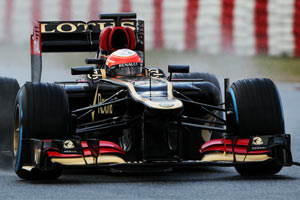I will try to explain myself better I have seen that some of the things I have said are not clear.
In my opinion the small periscope pipe draws air in, does not blow it out. I have come to that idea after reading some other posts and blogs, like somers' (which I liked) or scarbs', without being able to fix some things that seems inconsistent to me. If I tried to reverse, all the pieces I was missing seem to find their place.
I will try to itemize the things I did not understand:
- slot position: the f-duct in 2010 used blowing to stall the wing, but since then the rules have banned slots in the wings - so to go around that rule, the slots are placed in a different place, under the wing. In the first e20 drd version they were like this

on the e21 there is a slot pointing upwards (maybe some piece has not been shown yet?), like on the w03.
With the slots being placed there, to me it seems easier to cause stall if you get some air to go into the slit instead of blowing. The trajectory of the flow along the lower surface of the wing is curved, so to cause stall you have to disurb this curved path by putting in place an opposite pressure gradient, with lowered pressure on the outside of the curved trajectory. Thsi can be seen as a local increase in angle of attack. By blowing, you instead decrease this angle - create more favourable conditions for attachment.
Having the wing blown at low speeds to help
- stall behaviour: If I suppose that stall is achieved by blowing out of the slot, after stalling the suction peak on the wing is lost, so the pressure is higher and the hypotetical blowing is less effective, which could lead to reattachment. That seems undesirable. By sucking instead, the higher the pressure on the lower part of the wing, the greater the suction effect
-flow viz: though I am not an expert in interpreting flow viz, in the picture above that shows the separated wing I did not recognize a separation pattern on the slotted pillar, which I expected if the slots were blowing. )But maybe I have wrong expectation - this is not a strong point)
-pipe sizes: when I took a look at renault's f-duct on another thread here
http://www.f1technical.net/forum/viewto ... 0&start=15, I noticed that the pipes were sized very differently:

the ears were much smaller, the pipe blowing on the wing and the other pipe discharging between mainplane and beamwing had more or less the same section. On the drd there are much bigger ears, that feed a big main duct, with a much smaller pericope duct - if the working principle is the same, expect for the "passive" switching instead of driver operated, why are the pipes' sizes that different?
-fluidic switch: I have seen no hypotesis about how it could work, and it is difficult for me to imagine one. If I suppose that the periscope is drawing air in, there is no need for a fluidic switch, you need just a venturi section (from there comes the analogy with a mr proper spray)
-monkey seat on the outlet: if the periscope is blowing above a certain speed when the main pipe cannot expel any more flow, why is the big monkey seat needed? In 2013 lotus have got rid of the big monkey seat, but they still need the tongue after the exit of teh main pipe to drive the fluid. If the periscope is sucking and there is a throat in the main pipe to achieve the lower pressure needed, then the monkey seat is necessary to pull the flow out from the throat
-shape of the periscope / main pipe junction: it seems consistent with a 90° connection between periscope and main pipe, which is not necessary if the slots are blowing, whereas it is if the slits are sucking it is needed. But it is difficult to detect the exact shape of teh joint, so this is not a strong point either.
Sorry for the long post






 (Thanks to F1fanatic)
(Thanks to F1fanatic)






